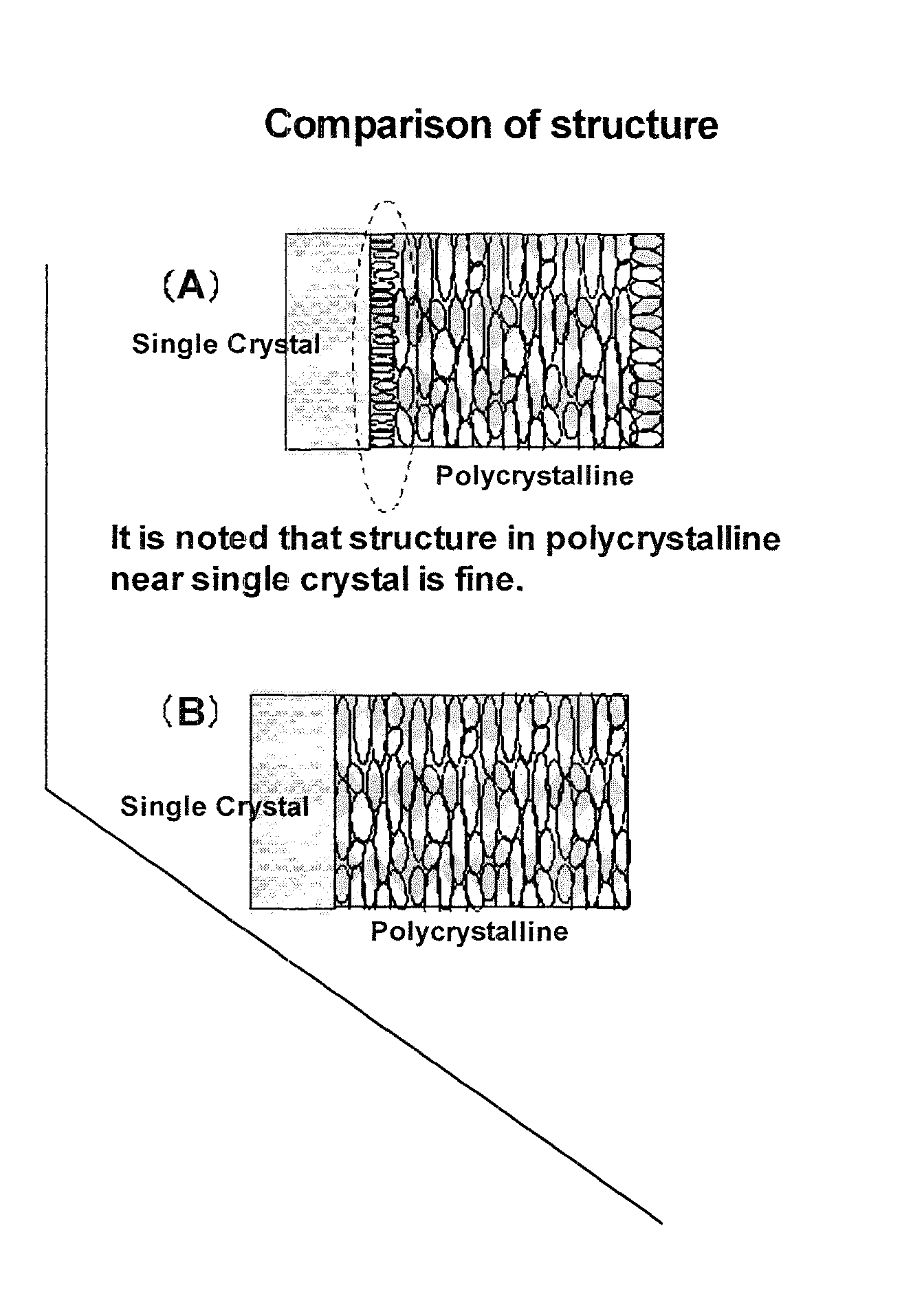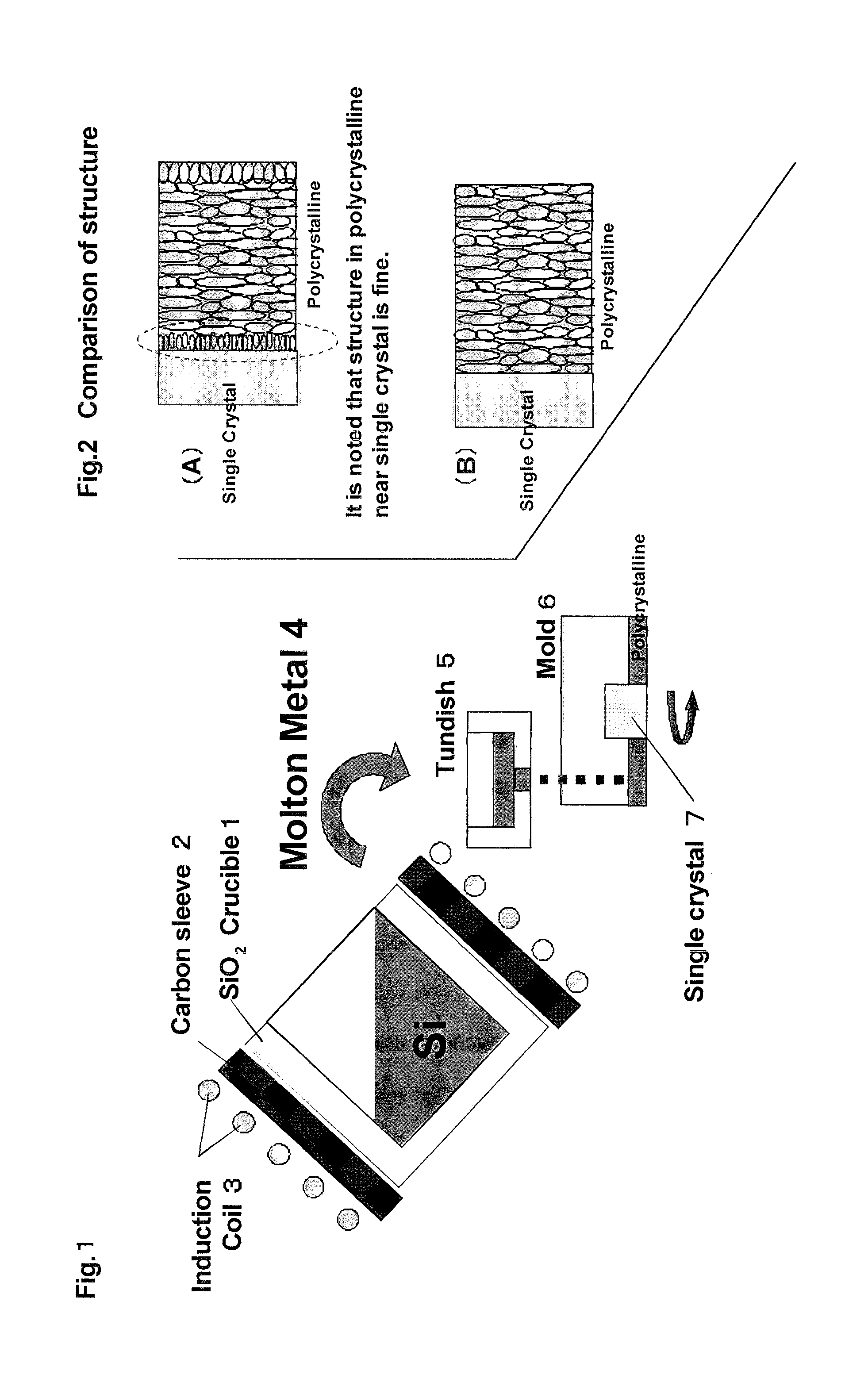Hybrid silicon wafer and method of producing the same
a technology of hybrid silicon and silicon wafer, which is applied in the field of hybrid silicon wafer, can solve the problems of increasing the cost of lsi process, and high cost of single crystal wafer having a diameter of 400 mm or more, so as to improve the production yield, reduce production costs, and facilitate the preparation of large ingots
- Summary
- Abstract
- Description
- Claims
- Application Information
AI Technical Summary
Benefits of technology
Problems solved by technology
Method used
Image
Examples
example 1
[0059]Amorphous silicon (having a purity of roughly 7N excluding dopants and gas components) having an average size of 30 mm to become the raw material of the polycrystalline silicon was placed in a quartz crucible surrounded with carbon, and the temperature was raised to 1500° C. in a vacuum based on high frequency induction heating to melt the silicon.
[0060]Meanwhile, as shown in FIG. 1, a single-crystal ingot 7 having a diameter of 200 mm, height of 220 mm and purity of 11N was set in a mold 6 having an inner diameter of 360 mm. The single-crystal ingot 7 was fixed upon setting its plane orientation to a prescribed position and placing a high melting point metal with greater specific gravity than Si thereon so as not move when molten metal is poured by. The overall mold was preheated to 1200° C. in order to reduce the thermal shock.
[0061]Subsequently, the silicon as the molten metal 4 in the crucible was cast up to a height of 100 mm via the tundish 5 while controlling the pour s...
example 2
[0065]Single-crystal silicon waste material having a diameter of roughly 10 mm and purity of 6N to become the raw material of the polycrystalline silicon was placed in a quartz crucible surrounded with carbon, and the temperature was raised to 1520° C. in a vacuum based on high frequency induction heating to melt the silicon.
[0066]Meanwhile, as shown in FIG. 1, a single-crystal ingot 7 having a diameter of 300 mm and height of 150 mm was set in a mold 6 having an inner diameter of 500 mm. The single-crystal ingot 7 was fixed upon setting its plane orientation to a prescribed position and so that it will not move when molten metal is poured by placing a high melting point metal with greater specific gravity than Si thereon.
[0067]The overall mold was preheated to 1250° C. in order to reduce the thermal shock. Subsequently, the silicon 4 as the molten metal in the crucible 1 was cast up to a height of 80 mm via the tundish 5 while controlling the pour spout, and the single-crystal ingo...
PUM
| Property | Measurement | Unit |
|---|---|---|
| average crystal grain size | aaaaa | aaaaa |
| average crystal grain size | aaaaa | aaaaa |
| diameter | aaaaa | aaaaa |
Abstract
Description
Claims
Application Information
 Login to View More
Login to View More - R&D
- Intellectual Property
- Life Sciences
- Materials
- Tech Scout
- Unparalleled Data Quality
- Higher Quality Content
- 60% Fewer Hallucinations
Browse by: Latest US Patents, China's latest patents, Technical Efficacy Thesaurus, Application Domain, Technology Topic, Popular Technical Reports.
© 2025 PatSnap. All rights reserved.Legal|Privacy policy|Modern Slavery Act Transparency Statement|Sitemap|About US| Contact US: help@patsnap.com


